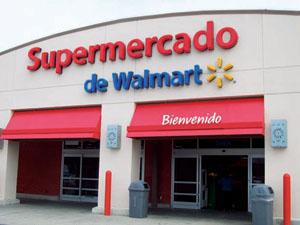Walmart formats target new customer segments
BENTONVILLE, Ark. —The phrase “serving the underserved” is one Wal-Mart executives generally use when discussing international growth opportunities, but that philosophy can be applied domestically as well, where multiple new formats in the experimentation phase are designed to appeal to new customers in new ways.
The most recent example is the Supermercado de Walmart format, which targets Hispanic consumers with its expanded fresh departments, reduced frozen and packaged goods selections, and an increased offering of brands familiar to Hispanics.
The first store opened in Houston last month inside a converted Neighborhood Market store in a predominantly Hispanic neighborhood. Chief merchandising officer John Fleming told analysts earlier this month that fresh merchandise is presented with authority in the store, which “got just incredible response from customers.” A second unit opened earlier this month in Phoenix, and it, too, is located inside a former Neighborhood Market store, so both units retained their drive-through pharmacies and are in the neighborhood of 40,000 sq. ft.
The conversion of two Neighborhood Markets doesn’t mean that the concept is dead, though; a new store that opened in late June in northwest Arkansas could breathe life into the concept that has never lived up to its potential since being introduced in fall 1998. The newest unit features an attractive earth-tone exterior, a Spanish-tile roof, low-rise walls constructed of natural stone and massive planters with flowers. The architecture and new branding elements give the building an upscale appearance, which was important given the location just outside the gated golf course community of Pinnacle Hills, Ark.
Although the store was not open at press time, the product assortment is expected to reflect the preferences of the upper-income tastes of the nearby residents, many of whom are executives with Wal-Mart or its suppliers. The store could serve as a model the company could use to appeal to what has been a largely untapped customer segment.
Between a new Neighborhood Market prototype and the introduction of Supermercado, it is easy to overlook the Marketside food stores, which debuted in Phoenix last year and were the buzz of the retail industry, along with Tesco’s Fresh and Easy Neighborhood Market stores. At 15,000 sq. ft., the Marketside stores are small by Walmart standards, and they are devoted almost exclusively to food, with only a limited assortment of health and beauty products and no pharmacy. Walmart recently rebranded those stores “Marketside by Walmart,” but so far there is no word on if or when the concept will be expanded. The same is true of Neighborhood Market and Supermercado.
Insight into those plans isn’t likely to come until this fall, when Wal-Mart holds its annual investor conference and updates the financial community on capital expenditure plans and other strategic initiatives. Even then, the company will be hard-pressed to convince analysts that the United States is an underserved market, especially in light of the toll exacted on the retail industry during the past several years by the slowdown in consumer spending. Bankruptcies, liquidations, store closures and sales declines at numerous companies have altered the retail landscape considerably, and most companies, including Wal-Mart, have pared their expansion plans. However, Wal-Mart has remained relatively unscathed, as its 2,630 supercenters, 883 discount stores and 154 neighborhood market-type stores generated sales last year of $256 billion, about $16 billion more than the previous year.
With the wind at the company’s back, even in a down economy, Walmart’s vice chairman, president and CEO of the U.S. division, Eduardo Castro-Wright, often speaks of the longer-term opportunities ahead for the company in the United States and references 15 unidentified markets where it has ample opportunity, assuming it can replicate the market share it has elsewhere in the country.
In addition to recent actions around format experimentation, Castro-Wright’s background as the former president and CEO of Wal-Mart de Mexico suggests the company’s U.S. operations may one day mirror the multiformat approach that exists in Mexico and in many of the other international markets where Wal-Mart operates. In Mexico, Wal-Mart operates super-centers, restaurants, department stores, supermarkets and multiple formats under the no-frills, limited-assortment Bodega Aurrera brand.
All told, the nearly $100 billion international division operates stores under 60 banners in 10 different formats in 15 countries. The strategy is due in large part to the fact that 80% of Wal-Mart’s international business is the result of acquisitions, and after a shift in strategy that took place roughly a decade ago, the company stopped changing the names of stores when it acquired another company.
The company has been given a sense of the opportunity based on the performance of its online business and the utilization of its free shipping service, known as Site-to-Store. Stores experiencing the highest customer traffic from people who place merchandise orders online tend to be just outside some of the nation’s largest urban areas, including New York, according to a Wal-Mart spokesperson. That explains why the Site-to-Store customer base has grown more than ninefold over the past 12 months, Castro-Wright noted.


